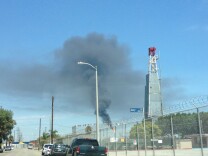
Next Up:
0:00
0:00
-
Listen Listen
Climate & Environment
Some of the country's highest home insurance prices are in the central U.S., a region generally considered to be protected from climate-driven disasters.
Listen
4:32
Sponsor
More Stories
-
State officials say they need a relatively new technology to achieve state climate goals. Opponents say it's just another lifeline for fossil fuels.
-
We’ve compiled dozens of tips to help get you through the rising temperatures in Southern California — from heat illness signs to finding a place to cool down.
-
You may have noticed you're being bitten here there and everywhere this year. Enjoy being dinner for the pesky bugs.
-
To state the obvious: California has a water problem. But experts say conservation alone can’t solve our water woes. Should recycled sewage water play a bigger role?
-
A California Newsroom investigation finds that the department's missteps potentially leave the state at greater risk of catastrophic fires.
-
Is it a lonely male looking for love? Call it a Tinder for birds.
-
This summer, millions of Angelenos can't use use drinkable water for outdoor irrigation more than twice a week. Here are tips how to conserve.
-
The final and most critical analysis yet from the United Nations Intergovernmental Panel on Climate Change lays out a stark picture of the future. Here's what that means for L.A.
-
From drenched Decembers to a record hot Super Bowl, we've seen winter on a rollercoaster in Southern California. Why?
-
Starting Jan. 1, 2022, California residents and businesses have been required to separate “green waste” from other trash and recycling. It’s a way to reduce the planet-heating greenhouse gases emitted by decomposing food in our landfills.
-
If you live near a steep, mountainous area that’s burned some time in the past few years, you need to prepare for debris flows when it rains.
-
Over the last year and a half, almost four dozen Cal Fire firefighters have suffered from heat illness during training, and since 2003 five have died.
Researchers found that in drier years, larger animals are more likely to head closer and closer to where people live.
Listen
4:05
Support your source for local news!
In case you missed it
-
911 recordings obtained by LAist shed light on why and how emergency planning continues to leave people with disabilities behind.
-
LAist investigates illicit dumping at three Antelope Valley sites.
-
An LAist investigation found toxic heavy metals in samples of fire retardant collected from the Palisades, Eaton and Franklin fires. Here's what that means.
More Stories
-
Rich countries are dodging responsibility for adaptation aid, infuriating leaders from vulnerable nations.
-
We're looking at dry weather and cooler nights for the week.
-
Steep slopes, weak rocks and water intrusion all make slides more likely.
-
Worm composting became especially popular during the pandemic, but it's never too late to get in the dirt.
-
Drilling in Culver City’s portion is set to end in 2029.
-
California’s sequoia population has taken a hit in the past few years. The National Park Service wants to help it rebound — but environmentalists are concerned the program could hurt more than it helps.
-
The National Weather Service has issued fire weather watch for portions of the Southland.
-
The climate crisis will increase the number of marine mammals needing treatment, experts say.
-
Today's temperatures have dropped to the upper 60s and it will be windy in parts of the Inland Empire and 5 Freeway corridor.
-
We need clear plans if we're going to have enough water for the future.




































